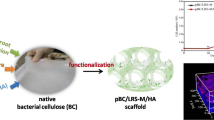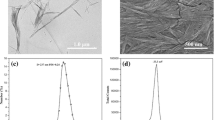Abstract
For both the incorporation of cells and future therapeutic applications the sterility of a biomaterial must be ensured. However, common sterilisation techniques are intense and often negatively impact on material physicochemical attributes, which can affect its suitability for tissue engineering and 3D printing. In the present study four sterilisation methods, autoclave, supercritical CO2 (scCO2) treatment, UV- and gamma (γ) irradiation were evaluated regarding their impact on material properties and cellular responses. The investigations were performed on methyl cellulose (MC) as a component of an alginate/methyl cellulose (alg/MC) bioink, used for bioprinting embedded bovine primary chondrocytes (BPCs). In contrast to the autoclave, scCO2 and UV-treatments, the γ-irradiated MC resulted in a strong reduction in alg/MC viscosity and stability after extrusion which made this method unsuitable for precise bioprinting. Gel permeation chromatography analysis revealed a significant reduction in MC molecular mass only after γ-irradiation, which influenced MC chain mobility in the Ca2+-crosslinked alginate network as well as gel composition and microstructure. With regard to cell survival and proteoglycan matrix production, the results determined UV-irradiation and autoclaving as the best candidates for sterilisation. The scCO2-treatment of MC resulted in an unfavourable cell response indicating that this method needs careful optimisation prior to application for cell encapsulation. As proven by consistent FT-IR spectra, chemical alterations could be excluded as a cause for the differences seen between MC treatments on alg/MC behaviour. This investigation provides knowledge for the development of a clinically appropriate 3D-printing-based fabrication process to produce bioengineered tissue for cartilage regeneration.








Similar content being viewed by others
References
Liaw C-Y, Guvendiren M. Current and emerging applications of 3D printing in medicine. Biofabrication. 2017;9(2):24102.
Ventola CL. Medical applications for 3D printing: current and projected uses. P T. 2014;39(10):704–11.
Billiet T, Vandenhaute M, Schelfhout J, Van Vlierberghe S, Dubruel P. A review of trends and limitations in hydrogel-rapid prototyping for tissue engineering. Biomaterials. 2012;33(26):6020–41.
Malda J, Visser J, Melchels FP, Jüngst T, Hennink WE, Dhert WJA et al. 25th anniversary article: engineering hydrogels for biofabrication. Adv Mater. 2013;25(36):5011–28.
Lee KY, Mooney DJ. Alginate: properties and biomedical applications. Prog Polym Sci. 2012;37(1):106–26.
Lee KY, Rowley JA, Eiselt P, Moy EM, Bouhadir KH, Mooney DJ. Controlling mechanical and swelling properties of alginate hydrogels independently by cross-linker type and cross-linking density. Macromolecules. 2000;33(11):4291–4.
Joydip K, Jin-Hyung S, Jinah, Jang S, Sung WK, Dong-Woo C. An additive manufacturing-based PCL–alginate– chondrocyte bioprinted scaffold for cartilage tissue engineering. J Tissue Eng Regen Med. 2013;9(11):1286–97.
Fedorovich NE, Schuurman W, Wijnberg HM, Prins H-J, van Weeren PR, Malda J et al. Biofabrication of osteochondral tissue equivalents by printing topologically defined, cell-laden hydrogel scaffolds. Tissue Eng Part C Methods. 2012;18(1):33–44.
Maher PS, Keatch RP, Donnelly K, Mackay RE, Paxton JZ. Construction of 3D biological matrices using rapid prototyping technology. Rapid Prototyp J. 2009;15(3):204–10.
Schütz K, Placht A-M, Paul B, Brüggemeier S, Gelinsky M, Lode A. Three-dimensional plotting of a cell-laden alginate/ methylcellulose blend: towards biofabrication of tissue engineering constructs with clinically relevant dimensions. J Tissue Eng Regen Med. 2017;11(5):1574–87.
Zehnder T, Sarker B, Boccaccini AR, Detsch R. Evaluation of an alginate-gelatine crosslinked hydrogel for bioplotting. Biofabrication. 2015;7(2):25001.
Hwang CM, Ay B, Kaplan DL, Rubin JP, Marra KG, Atala A et al. Assessments of injectable alginate particle-embedded fibrin hydrogels for soft tissue reconstruction. Biomed Mater. 2013;8(1):14105.
Lode A, Krujatz F, Brüggemeier S, Quade M, Schütz K, Knaack S et al. Green bioprinting: fabrication of photosynthetic algae-laden hydrogel scaffolds for biotechnological and medical applications. Eng Life Sci. 2015;15(2):177–83.
Seidel J, Ahlfeld T, Adolph M, Kümmritz S, Steingroewer J, Krujatz F et al. Green bioprinting: extrusion-based fabrication of plant cell-laden biopolymer hydrogel scaffolds. Biofabrication. 2017;9(4):45011.
Li H, Tan YJ, Leong KF, Li L. 3D Bioprinting of highly thixotropic alginate/methyl cellulose hydrogel with strong interface bonding. ACS Appl Mater Interfaces. 2017;9(23):20086–97.
Ahlfeld T, Cidonio G, Kilian D, Duin S, Akkineni AR, Dawson JI et al. Development of a clay based bioink for 3D cell printing for skeletal application. Biofabrication. 2017;9(3):e034103.
Wang Q, Sun J, Yao Q, Ji C, Liu J, Zhu Q. 3D printing with cellulose materials. Cellulose. 2018;25:1–27.
Nasatto PL, Pignon F, Silveira JLM, Duarte MER, Noseda MD, Rinaudo M. Methylcellulose, a cellulose derivative with original physical properties and extended applications. Polymers. 2015;7(5):777–803.
Sarma NJ, Takeda A, Yaseen NR. Colony forming cell (CFC) assay for human hematopoietic cells. J Vis Exp. 2010;46:3–7.
Munarin F, Bozzini S, Visai L, Tanzi MC, Petrini P. Sterilization treatments on polysaccharides: effects and side effects on pectin. Food Hydrocoll. 2013;31(1):74–84.
Mendes GCC, Brandão TRS, Silva CLM. Ethylene oxide sterilization of medical devices: a review. Am J Infect Control. 2007;35(9):574–81.
Dai Z, Ronholm J, Tian Y, Sethi B, Cao X. Sterilization techniques for biodegradable scaffolds in tissue engineering applications. J Tissue Eng. 2016;7:1–13.
Ahmed EM. Hydrogel: Preparation, characterization, and applications: a review. J Adv Res. 2015;6(2):105–21.
Karajanagi SS, Yoganathan R, Mammucari R, Park H, Cox J, Zeitels SM et al. Application of a dense gas technique for sterilizing soft biomaterials. Biotechnol Bioeng. 2011;108(7):1716–25.
Damar S, Balaban MO. Review of dense phase CO2 technology: microbial and enzyme inactivation. J Food Sci. 2006;71(1):1–11.
Bernhardt A, Wehrl M, Paul B, Hochmuth T, Schumacher M, Schütz K et al. Improved sterilization of sensitive biomaterials with supercritical carbon dioxide at low temperature. PLoS ONE. 2015;10(6):e0129205. 19 pages
Spilimbergo S, Dehghani F, Bertucco A, Foster NR. Inactivation of bacteria and spores by pulse electric field and high-pressure CO2 at low temperature. Biotechnol Bioeng. 2003;82(1):118–25.
Collier JP, Sperling DK, Currier JH, Sutula LC, Saum KA, Mayor MB. Impact of gamma sterilization on clinical performance of polyethylene in the knee. J Arthroplast. 1996;11(4):377–89.
El-ashhab F, Sheha L, Abdalkhalek M, Khalaf HA. The influence of gamma irradiation on the intrinsic properties of cellulose acetate polymers. J Assoc Arab Univ Basic Appl Sci. 2013;14(1):46–50.
Palmer I, Clarke S, Nelson J, Schatton W, Dunne N, Buchanan F. Identification of a suitable sterilisation method for collagen derived from a marine Demosponge. Int Nano Biomater. 2012;4(2):148–63.
Stoppel WL, White JC, Horava SD, Henry AC, Roberts SC, Bhatia SR. Terminal sterilization of alginate hydrogels: efficacy and impact on mechanical properties. J Biomed Mater Res B Appl Biomater. 2014;102(4):877–84.
Goldman M, Gronsky R, Ranganathan R, Pruitt L. The effects of gamma radiation sterilization and ageing on the structure and morphology of medical grade ultra high molecular weight polyethylene. Polym. 1996;37(14):2909–13.
Maslennikova A, Kochueva M, Ignatieva N, Vitkin A, Zakharkina O, Kamensky V et al. Effects of gamma irradiation on collagen damage and remodeling. Int J Radiat Biol. 2015;91(3):240–7.
Meechan P, Wilson C. Use of ultraviolet lights in biological safety cabinets: a contrarian view. Appl Biosaf. 2006;11(4):222–7.
Huebsch N, Gilbert M, Healy KE. Analysis of sterilization protocols for peptide-modified hydrogels. J Biomed Mater Res B Appl Biomater. 2005;74(1):440–7.
Wilda H, Gough JE. In vitro studies of annulus fibrosus disc cell attachment, differentiation and matrix production on PDLLA/45S5 Bioglass composite films. Biomaterials. 2006;27(30):5220–9.
Reza A T, Nicoll S. B. Hydrostatic pressure differentially regulates outer and inner annulus fibrosus cell matrix production in 3D scaffolds. Ann Biomed Eng. 2008;36(2):204–13.
Bryant SJ, Anseth KS. Hydrogel properties influence ECM production by chondrocytes photoencapsulated in poly (ethylene glycol) hydrogels. J Biomed Mater Res. 2002;59(1):63–72.
Pan T, Song W, Cao X, Wang Y. 3D Bioplotting of gelatin/alginate scaffolds for tissue engineering: influence of crosslinking degree and pore architecture on physicochemical properties. J Mater Sci Technol. 2016;32(9):889–900.
Leo WJ, Mcloughlin AJ, Malone DM. Effects of sterilization treatments on some properties of alginate solutions and gels. Biotechnol. 1990;6(1):51–3.
Young J, So J, Park H, Won J. Effects of intermittent hydrostatic pressure magnitude on the chondrogenesis of MSCs without biochemical agents under 3D co-culture. J Mater Sci Mater Med. 2012;23(11):2773–81.
Park JY, Choi YJ, Shim JH, Park JH, Cho DWJ. Development of a 3D cell printed structure as an alternative to autologs cartilage for auricular reconstruction. Biomed Mater Res B Appl Biomater. 2016;105(5):1–13.
Kundu J, Shim JH, Jang J, Kim SW, Cho DW. An additive manufacturing-based PCL–alginate– chondrocyte bioprinted scaffold for cartilage tissue engineering. Tissue Eng Regen Med. 2013;9(11):1286–97.
Hall AC, Starks I, Shoults CL, Rashidbigi S. Pathways for K+transport across the bovine articular chondrocyte membrane and their sensitivity to cell volume. Am J Physiol. 1996;270(5):C1300–10.
Fischbach C, Tessmar J, Lucke A, Schnell E, Schmeer G, Blunk T et al. Irradiation affect polymer properties relevant to tissue engineering? Surf Sci. 2001;491(3):333–45.
Janorkar A, Metters A, Hirt D. Degradation of Poly(L-Lactide) films under ultraviolet- induced photografting and sterilization conditions. Surf Sci. 2006;106(2):1042–7.
Yixiang D, Yong T, Liao S, Chan CK, Ramakrishna S. Degradation of electrospun nanofiber scaffold by short wave length ultraviolet radiation treatment and its potential applications in tissue engineering. Tissue Eng Part A. 2008;14(8):1321–9.
Koch HH, Pimsler M. Evaluation of Uvitex 2B: a nonspecific fluorescent stain for detecting and identifying fungi and algae in tissue. Lab Med. 1987;18(9):603–6.
Rasconi S, Jobard M, Jouve L, Sime-Ngando T. Appl Environ Microbiol. 2009;75(8):2545–53.
O’Brien FJ. Biomaterials & scaffolds for tissue engineering. Mater Today. 2011;14(3):88–95.
Law N, Doney, Glover H, Qin Y, Aman ZM, Sercombe TB et al. J Mech Behav Biomed Mater. 2018;77:389–99.
Hugo WB. A brief history of heat, chemical and radiation preservation and disinfection. Int Biodeterior Biodegrad. 1995;36(3–4):197–217.
Hermannova M, Bezáková Z, Ebringerova A, Malovı A, Dřímalová E, Malovíková A et al. Effect of microwave irradiation on the molecular and structural properties of hyaluronan. Carbohydr Polym. 2008;73:640–6.
Hoffman AS. Hydrogels for biomedical applications. Adv Drug Deliv Rev. 2002;54:3–12.
Shahriari D, Koffler J, Lynam DA, Tuszynski MH, Sakamoto JS. Characterizing the degradation of alginate hydrogel for use in multilumen scaffolds for spinal cord repair. J Biomed Mater Res A. 2016;104(3):611–9.
Ersch C, Linden E, Martin A, Venema P. Food Hydrocoll. 2016;52:991–1002.
Meyer M, Prade I, Leppchen-Fröhlich K, Felix A, Herdegen V, Haseneder R et al. Sterilisation of collagen materials using hydrogen peroxide doted supercritical carbon dioxide and its effects on the materials properties. J Supercrit Fluids. 2015;102:32–9.
Acknowledgements
The authors thank Ms Ortrud Zieschang for preparation of SEM samples, the microscopy facility CFCI of the TU Dresden for providing equipment and support in cell imaging as well as the Institute of Natural Materials Technology, Chair of Food Engineering at TU Dresden for the opportunity to perform gel permeation chromatography (GPC). This work was supported by the European Social Fund (ESF) and Free State of Saxony (Young Researchers Group IndivImp at Technische Universität Dresden), the German Research Society (DFG) as part of the priority program SPP 1934 as well as the German Center for Diabetes Research (DZD). Partial funding was received from a Santander Research Scholarship, awarded to Ella Hodder.
Author information
Authors and Affiliations
Corresponding authors
Ethics declarations
Conflict of interest
The authors declare that there is no conflict of interest.
Additional information
Publisher’s note: Springer Nature remains neutral with regard to jurisdictional claims in published maps and institutional affiliations.
Rights and permissions
About this article
Cite this article
Hodder, E., Duin, S., Kilian, D. et al. Investigating the effect of sterilisation methods on the physical properties and cytocompatibility of methyl cellulose used in combination with alginate for 3D-bioplotting of chondrocytes. J Mater Sci: Mater Med 30, 10 (2019). https://doi.org/10.1007/s10856-018-6211-9
Received:
Accepted:
Published:
DOI: https://doi.org/10.1007/s10856-018-6211-9




